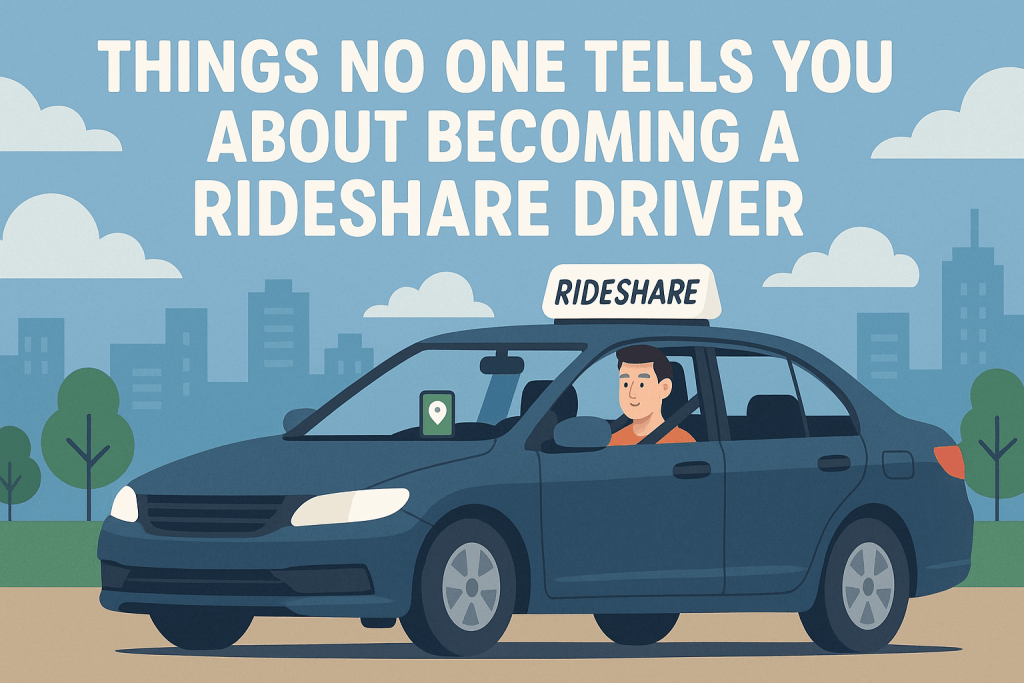Driving for rideshare services like Uber and Lyft seems pretty straightforward, right? The ads make it sound amazing – flexible hours, decent pay, be your own boss. Just sign up, turn on the app, and start making money whenever you want.
Well, let me tell you, once you actually get out there and start picking up passengers, you realize there’s a whole lot more to this gig than anyone mentioned. Sure, there are some great perks, but there are also some surprises that can catch you off guard if you’re not prepared.
Whether you’re thinking about driving for Uber, Lyft, or both, you really need to know what you’re getting into before you commit. And trust me, understanding things like becoming a Lyft driver requirements is just the tip of the iceberg when it comes to what you need to figure out.
Here are five things nobody bothers to tell you about becoming a rideshare driver.

Your Car Will Wear Out Faster Than You Think
This one hits every new driver pretty hard. All those extra miles you’re putting on your car don’t just disappear – they add up fast and your vehicle is going to show it. We’re talking about way more wear and tear than your regular commute or weekend errands.
Your maintenance schedule basically gets accelerated. Oil changes, tire rotations, brake pads – everything needs attention more frequently when you’re driving professionally. And trust me, these costs can eat into your earnings faster than you’d expect.
Then there’s the resale value issue. When it comes time to sell or trade in your car, all those rideshare miles are going to affect what it’s worth. High-mileage vehicles just don’t hold their value the same way.
The one silver lining? You can deduct a lot of these vehicle expenses on your taxes. But that means keeping track of everything, which brings us to a whole other challenge we’ll get to later.
Not All Hours Are Equally Profitable
Here’s something the recruiting ads don’t emphasize: your earnings are going to vary wildly depending on when and where you drive. Surge pricing during peak times can make certain hours incredibly profitable, while other times you’ll sit around making basically nothing.
Those slow periods can be really frustrating. You’re online, waiting for ride requests, but your car is just sitting there burning gas while you’re not earning anything. It’s not like a regular job where you get paid for your time regardless of how busy things are.
Learning your local market becomes super important. You need to figure out when events are happening, where people tend to need rides, and how to position yourself to catch surge pricing when it kicks in.
The apps do try to help by showing you busy areas and predicting demand, but there’s definitely a learning curve to maximizing your earning potential.
Dealing with Difficult or Intoxicated Passengers
Nobody really prepares you for some of the passengers you’re going to encounter. Most people are fine, but the difficult ones? They can make for some seriously memorable rides, and not always in a good way.
Drunk passengers are probably the biggest challenge, especially during weekend nights. They can be unpredictable, messy, or sometimes even aggressive. Learning how to stay calm and professional while keeping yourself safe becomes a real skill.
You always have the right to refuse service if you feel unsafe, but knowing when to exercise that right takes some experience. Sometimes it’s better to end a ride early than deal with a situation that’s escalating.
Getting a dashcam is one of the smartest investments you can make. It protects you from false accusations and provides evidence if something really goes wrong during a ride.
You’ll Spend More Time Waiting Than Driving
This was probably the biggest surprise for me when I started driving. I thought I’d be constantly picking up and dropping off passengers, but the reality is you spend a lot of time just waiting for the next ride request.
That idle time between rides really cuts into your hourly earnings. You’re not making money while you’re sitting in a parking lot waiting for a ping, but you’re still using gas and putting wear on your car.
Learning how to position yourself strategically can help reduce downtime. Some drivers get really good at predicting where demand will be and positioning themselves accordingly.
The balance between short trips and longer rides is tricky too. Short trips mean more frequent pickups but also more time spent navigating to passengers. Longer rides mean better money per trip but potentially longer waits between rides.
The Real Story Behind the Steering Wheel
Driving for Uber or Lyft gives you flexibility and potential hours to earn an income, but it has its own surprises that are never advertised in the numerous shiny recruitment ads! Whether it’s unexpected auto expenses or difficult riders, rideshare driving has its own unique challenges.
Realizing these realities early, helps you make a better decision if this is for you – whether as a side hustle or something more substantial.
Know that you should do your due diligence before you sign up, and learn about all of the requirements and expectations, and that when you sign up, you’re doing more than simply driving people around.
When you understand the challenges and realities you are likely to encounter, you will ideally have realistic expectations, which will give you a very realistic chance at actually making this work financially and personally.
